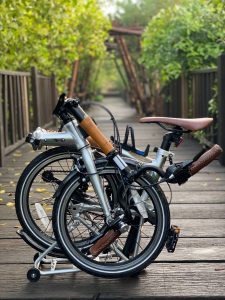Bike gears explained – shifting gears for beginners
- Michael
- Last Updated August 27, 2023
We are a reader supported site. We earn commissions when you buy through links on our site. Learn more.
I’ve enjoyed riding bikes since I was a kid. But it wasn’t until years of riding that I realized I had no idea how my bikes work. So, I set out to learn about the different parts of a bike and its functions. If you’re like me, you agree that one of the most intriguing parts of a bike is its gears. In this article, you’ll have all your curiosities about bike gears explained.
Read More: Bike Seat Height – How To Set The Saddle Height On Your Bike
The Purpose of Bike Gears
Anyone who has ridden a bike will know that in the most basic sense, shifting gears changes how difficult it is to pedal. In lower gear settings, your legs churn with relative ease. Higher settings call for more effort.
But what is the purpose of these changes in difficulty?
Gears help bikers adapt to variations in terrain. For example, some gear settings are ideal for pedaling uphill, while others are ideal for declines.
The idea here is to help the cyclist maintain a perfect rhythm with their feet as they ride. A rhythm makes for a more efficient ride as the gears allow you to maintain the same cadence as you ride over different terrain types.
Different Types of Bike Gears
In general, there are four standard varieties of bike gears. Within those broad categories, there are additional types of bike gears. But for now, let’s look at the kinds of gears you can expect to find:
- Single-speed
- Fixed gears
- Hub gears
- Derailleur gears
Let’s see what advantages each of these kinds of gears have to offer.
Single-Speed Gears
Single-speed gears are one of the simplest types of gears you will find. These gears do not offer you any shifting options. Instead, the difficulty of pedaling will remain the same in all settings.
Advanced cyclists will not likely enjoy single speed bikes because they do not offer much control when responding to topography changes.
But single speed bikes are great for casual riders. If you use your bike for simple trips over terrain that is not too challenging, there is no need for a bike with complicated gear settings.
Fixed Gears
Fixed gear bikes are almost the same as single gear bikes. They give the rider no ability to shift gears. But there is one important distinction.
With single gear bikes, the wheels can continue to rotate even when you are not pedaling. The same does not apply to fixed gear bikes.
Rather than rotating freely, the pedals and wheels must spin together. That means that at no time in the bike’s motion will the pedals stop turning.
This can be a disadvantage, especially when riding downhills. On a decline, a fixed gear bike does not allow you to coast as other types of bikes would. Fixed settings can lead to you building up more speed than you need.
Hub Gears
Unlike single-speed and fixed gear bikes, hub gears have multiple gears. A protective compartment contains and protects these gears.
Hub gears are not the most common type of bike gear. But in recent years they have started to gain more popularity. The increase in popularity reflects improvements to the hub gear mechanics.
Hub gears are more complex than other types of gears, but they have advantages as well. For instance, a cyclist riding a hub gear bike can shift gears while still and shift multiple gears at once.
These gears also need less maintenance than other types. But even with these benefits, hub gears are not the most widespread of all bike gears. That distinction belongs to this last kind of bike gear.
Derailleur Gears
Derailleur gear bikes are the most common. These are the gears one typically imagines when they imagine a standard bike.
Derailleur gears allow riders to shift between a set number of gears, like a hub gear. But derailleur gears are exposed to the open air rather than remaining protected in a casing.
Exposure can lead to more maintenance issues with derailleur gears. But these gears also have a simple mechanical operation and are reliable in most cases.
Now that we have reached this standard type of bike gear, it is time to learn some bike gear anatomy. Recognizing the various parts will help you understand how derailleur gear bikes operate.
Derailleur Gear Anatomy
Derailleur gears typically include two sets of gears.
The first set of gears connects to the pedals. At this point is where the power from your legs transfers into the bike gear system.
The second set of gears connects to the back wheel. This is where the power you generate begins to turn your bike’s wheel, causing you to move forward.
Both the front and the rear gear sets often include multiple gears of varying sizes. However, the number of gears on the back set is usually higher.
A chain connects the front gear set to the back gear set. When you shift, the chain moves from one gear within a group to another. The shift results in your pedaling becoming harder or easier.
The derailleur itself is the part of the gear that guides the chain to the next gear.
Now that you know the basics of bike gear components, you’re ready to learn about one of the most common ways to classify bikes.
What is Bike “Speed?”
Most who are familiar with cycling have heard that bikes can have different “speeds.” But what does the term mean?
Bike speed is somewhat of a misnomer as the actual speed of your bike depends on your output and other features of the bike.
But it is still important to know what speed means as it relates to bike gears. Here is how you can determine the speed of your bike:
- Count the number of gears in your front gear set
- Count the number of gears in your rear gear set
- Multiply those two numbers
The number you end up with is the speed of your bike. A 10 speed is one typical example. Speed is essential but if you are new to biking, just remember this. The higher your bike speed is, the more gears you have. The more gears you have, the more control you have over shifting in response to terrain variations.
How to Shift Gears on a Bike
Knowing the names and functions of different bike gears is not as important as knowing how to use them. Many casual cyclists fail to recognize that there is a degree of technique in shifting gears. Let’s explore some of the ways you can improve your gear shifting.
As you ride, your goal should be to maintain the same rhythm with your legs throughout your ride. As you ride up or downhill, shifting lets you change your power output without changing your pedaling cadence.
On the average bike, you will find two shifters on each handle.
One shifter controls the front gears. It operates the larger gears that influence the general level of output you need to give.
The other shifter controls the smaller gears on the read gear set. These smaller gear changes let you fine-tune your gear selection.
As you approach a change in terrain, you should anticipate the gear shift you will need to make. Planning ahead prepares you and your bike for the difference in the output you will need to ascend or descend a hill.
Knowing how to maintain a steady rhythm using your gears can make you a more efficient cyclist. So try to focus on your shifting habits on your next ride.
Bike Gear Maintenance
Maintenance affects the longevity and performance of your bike. By adhering to correct maintenance habits, you can help your bike operate to its full potential.
Bike gears are one of the most critical aspects of your bike. So, you will need to pay special attention to them regularly.
In general, you want to make sure that your bike gears are clean. This alone can extend your gear’s lifespan. You will also want to look for any signs of wear that may indicate a part of your gears needs a replacement.
Some suggest that you should check and clean your gears every week. However, this can vary based on how much time you spend riding. The most important lesson here is that gear maintenance should not be overlooked.
Common Bike Gear Problems and How to Fix Them
With a reasonable understanding of how gears work, let’s cover some of the most common gear problems. In the following sections, we will detail some of the ways gears can malfunction and the measures you can take to repair them. Since most models are derailleur gears, we will focus mainly on issues with that system.
Chain Malfunctions
The chain is the main component that transfers power from your pedaling to your bike’s wheels. As a result, your chain is always under stress as you ride.
Over time, stress can cause significant wearing to occur on your chain. When this happens, you may notice that it is suddenly more difficult to shift gears. You may also hear noises as you attempt to shift.
As a form of preventative maintenance, you should ensure that your chain remains lubricated. Regular lubrication can contribute to the longevity of your chain and the gears themselves.
In cases of extreme wear, your chain may be beyond repair. In those cases, you can simply find a replacement chain.
Shifter Cable Tension
The shifter cable is an integral part of your bike’s gears. It plays an essential role in moving your chain from one gear to the next when you attempt to shift.
For your shifter cable to work correctly, it needs to have the proper tension and sufficient lubrication. If either of these needs are not met, you may have difficulty changing gears.
A faulty shifter cable is one of the most common reasons that bike gears fail to shift. So, if you notice a gear problem, the shifter cable is one of the first places you should look.
Make sure that the cable is clean and free of rust. This ensures that it will slide smoothly in response to your shifting. Then you should check to see if your line is lacking tension. Either problem could prevent you from shifting smoothly.
Derailleur Alignment
Derailleurs are not the sturdiest objects. As such, your derailleur could fall out of alignment as you ride your bike.
Some derailleurs are out of alignment from the moment of purchase. Others bend through regular use.
Regardless of the cause, a poorly aligned derailleur will interfere with your gear shifting. Fortunately, repairing a derailleur is not too challenging.
There are specialty tools that you can use to fix your derailleur by yourself. Your main goal is to make sure that your derailleur is in straight vertical alignment. This is the best position from which the derailleur can feed the chain to the next gear.
General Wear and Tear
Bike gears include several components that must function well for your shifting to be a seamless process. Any one of these components can break or wear down over time.
As a part of your regular maintenance checks, you should always look for signs of excessive wear. Your chain, gears, derailleurs, and shifting levers can all wear down and compromise your shifting system.
When in doubt, seek a replacement for a component that looks past its prime. Replacing equipment, when needed, can reduce the risk of a breakdown while riding.
Conclusion
Knowing more about the mechanics of your bike can help a lot when your bike breaks down. This knowledge can also give you a deeper appreciation for your bike. One of the most essential elements of a modern bike is the gears. Gears are useful when you attempt to ride on inclines or declines. That’s why knowing a little bit about how gears work and how to fix them can be invaluable to a cyclist.

Michael
Hi, my name is Michael and I'm the chief editor of this website.
I've been riding all sorts of bikes for over a decade now and don't plan on stopping anytime soon.
Everyday, I learn new things and want to share my experiences with others.
Ready to join me on my journey?






